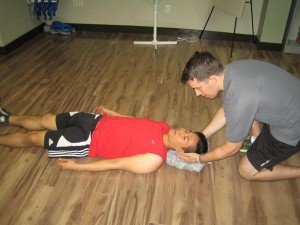Standard First Aid explains the difference between HOPS and SOAP format in assessing any injury.
Before assessing any injury, the opposite (non-injured) body part should be

assessed. This preliminary step in the injury evaluation process helps the individual, preferably with first aid training and CPR courses, to determine the relative dysfunction of the injured body part. If an injury occurs to one of the extremities, the results of individual tests performed on the non-injured body part can be compared with those for the injured body part. Differences can indicate the level and severity of injury. The baseline of information gathered on the non-injured body part also can be used as a reference point to determine when the injured body part has been rehabilitated and, as such, when to allow return to full participation in an activity. Under most circumstances, assessment of the non-injured body part should precede assessment of the injured body part. In some acute injuries, such as fractures or dislocations, assessment of the non-injured body part is not necessary.
The injury evaluation process must include several key components namely, taking a history of the current condition, visually inspecting the area for noticeable abnormalities, physically palpating the region for abnormalities, and completing functional and stress tests. Although several evaluation models may be used, each follows a consistent, sequential order to ensure that an essential component is not omitted without sufficient reason to do so. Two popular evaluation methods are the HOPS format and the SOAP note format. Find for the nearest first aid and CPR training locations near you.
Firstly, the HOPS format uses both subjective information, such as history of the injury, and objective information, such as observation and inspection, palpation, and special testing, to recognize and identify problems contributing to the condition. This format is easy to use and follows a basic, consistent format. The HOPS format focuses on the evaluation component of injury management and excludes the rehabilitation process. The subjective evaluation, such as history of the injury, includes the primary complaint, mechanism of injury, characteristics of the symptoms, and related medical history. This information comes from the individual and reflects his or her attitude, mental condition, and perceived physical state. The objective evaluation, like observation and inspection, palpation, and special tests, provides appropriate, measurable documentation relative to the individual’s condition. Measurable factors may include edema, ecchymosis, atrophy, range of motion (ROM), strength, joint instability, functional disability, motor and sensory function, and cardiovascular endurance. This information can be measured repeatedly to track progress from the initial evaluation through final clearance for discharge and return to participation in a sport or other physical activity. A detailed postural assessment and gait analysis also may be documented during the objective evaluation.
The second evaluation method is the SOAP Note Format. It provides a more detailed and advanced structure for decision making and problem solving in injury management. Used in many physical therapy clinics, sports medicine clinics, and athletic training facilities, these notes document patient care and serve as a vehicle of communication between the on-site clinicians and other health care professionals. These notes are intended to provide information concerning the ongoing status and tolerance of a patient and, in doing so, to avoid duplication of services by health care providers. The subjective and objective evaluations are identical to those used in the HOPS format; however, two additional components are added to the documentation: assessment, and planning. It is common practice to use abbreviations throughout the notes.
Each evaluation method has its advantages, but the SOAP note format is much more inclusive of the entire injury management process.
Standard First Aid References:
Documenting general observations. Nursing 2006; 36(2):25.
